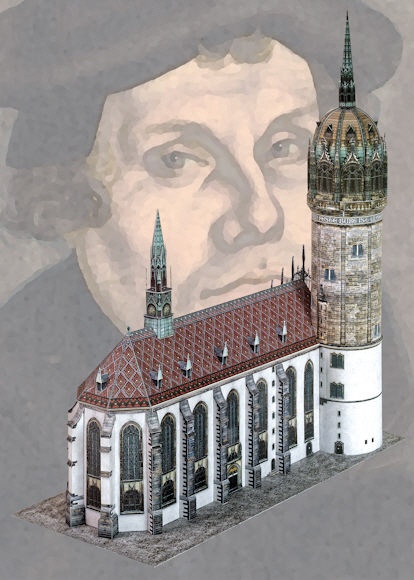Wittenberg Castle Church

Scale: 1:200
Length: 38 cm
Width: 18 cm
Height: 44 cm
Degree of difficulty: 2 (moderately difficult)
Number of sheets: 7.5
Wittenberg Castle Church
From 1340, All Saints’ Chapel stood very close to Wittenberg Castle. However, from 1489 to 1509 Elector Friedrich the Wise had the castle and chapel pulled down due to their state of disrepair and a new Electoral Castle (Residenzschloss) and church were built. Famous artists such as Lucas Cranach the Elder, Albrecht Dürer and Tilman Riemenschneider contributed to the construction of the building and furnishings. The new Castle Church was consecrated to All Saints in 1503 and from 1507 it was the university church. Students were awarded their doctorates here. Academic dignitaries of the university were buried here.
The Castle Church is most famous because of the Reformer Martin Luther. He studied Theology in Wittenberg from 1508 and in 1512 became Doctor of Theology. Later he lectured at Wittenberg University. In October 1517 Martin Luther published 95 Theses against the Catholic Church’s selling of indulgences. According to tradition, he posted them on the main door of the Castle Church. After his long stay at Wartburg Castle he often returned to Wittenberg to preach in the Castle Church. In 1525 Protestant services were introduced in the Castle Church. Friedrich the Wise died in the same year, a great supporter of Martin Luther. He was buried in the Castle Church. The graves of Martin Luther and Philipp Melanchthon can also be seen in the Castle Church.
Wittenberg Castle Church suffered from serious damage many times. During the Seven Years’ War it burned to the ground. Many valuable objects were thus destroyed, among them the Theses Door at the main portal. During the Siege of Wittenberg by the Prussians in 1814 the new building of the Castle Church was once more damaged by fire. Subsequently, the Prussians converted the castle into barracks. In 1817 the university was relocated to Halle. After that, the Castle Church went to the newly-founded Evangelical Preacher’s Seminary. In 1858 King Friedrich Wilhelm IV donated a new Theses Door made of bronze. Since the end of the 19th century the church has been an official memorial of the Reformation. It was reconstructed at that time in Neo-Gothic style. At the Neo-Gothic tower, a metre-high inscription made of mosaic stones shows words from one of Luther’s hymns “Ein feste Burg ist unser Gott” (A mighty fortress is our God).
From 1978 to 1992 the famous theologian Friedrich Schorlemmer was a preacher at the Castle Church and lecturer at the Preacher’s Seminary. He was joint founder of the peace movement “Schwerter zu Pflugscharen” (Swords to Ploughshares). The GDR government banned the use of this expression. Subsequently, at a campaign during the “Kirchentag” (Church Convention) in Wittenberg in 1983, Schorlemmer re-forged a sword to a ploughshare. From October 1989 to March 1990, at the time of the German Reunification, prayer services took place in the Castle Church “For the Restoration of the Country”.
On the occasion of the 500th Anniversary of Martin Luther’s birthday in 1983, twelve glass images of European Reformers were put into the lower side windows. These had been commissioned by the Lutheran World Federation. Since 1996 the church has been on the World Heritage List of the UNESCO. During a roof renovation in 1999-2000, the constructors went back to the style in the year 1892 and so the church was given a roof made of coloured glazed tiles.
